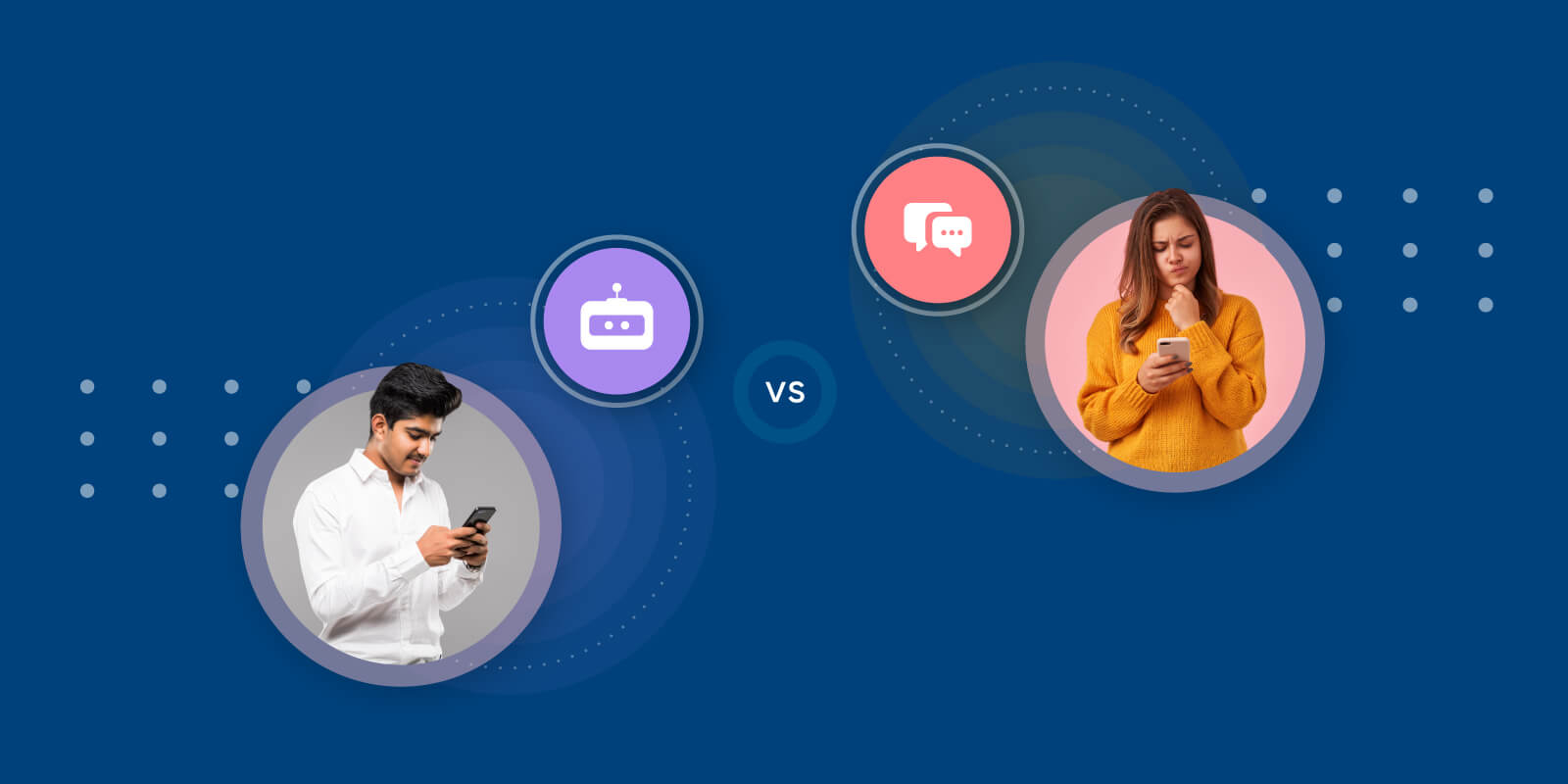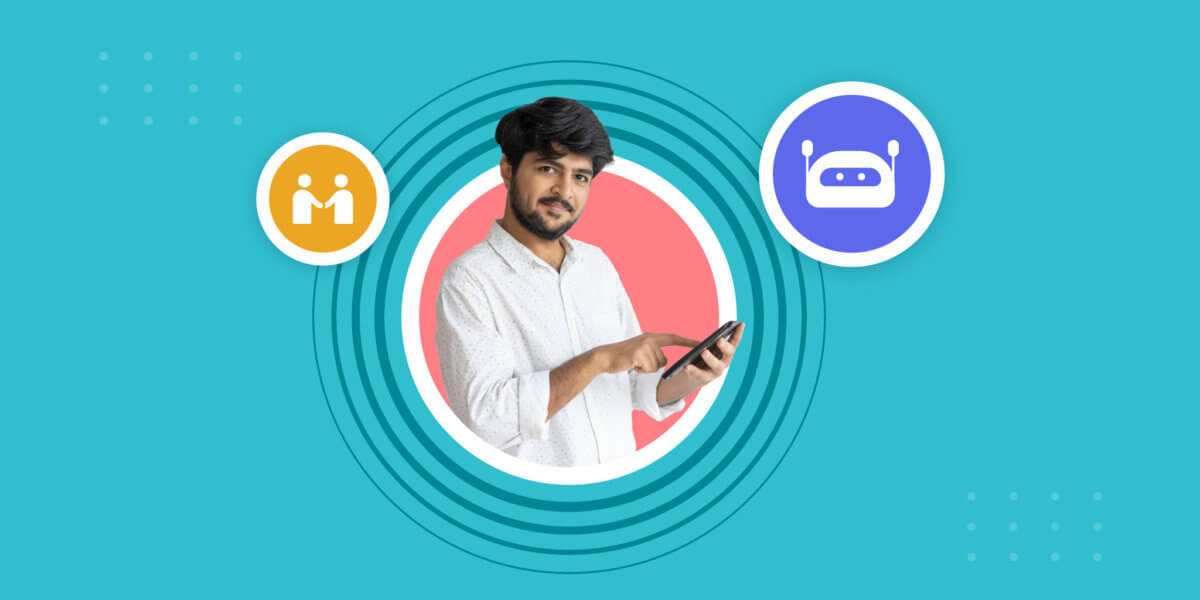Conversational AI vs Chatbots: What’s the Difference?

Conversational AI vs Chatbots: What’s the Difference?
Both the conversational AI solutions and chatbots work with a similar aim of offering customer service and ensuring better engagement. So what’s the difference? We find out in this post.
Digitisation has given rise to various concepts that have offered leverage to businesses to operate smoothly, even in adverse situations. From the online marketplace to smart conversational AI solutions that allow us to interact with the customers, technology has offered the facility for the business to serve the customers most efficiently.
We are writing this post because there has been misinterpretation and misleading semantics that creates an environment forcing the users to interchange and use conversational AI and chatbots.
Although the two concepts are interlinked, and using them interchangeably is valid to some extent. Still, in the context of the business, one needs to understand the difference between conversational AI chatbots and chatbots.
Both the conversational AI solutions and chatbots work with a similar aim of offering customer service and ensuring better engagement. At Verloop.io, we offer services that provide better customer service, support, and engagement with the help of conversational AI.
Chatbots and their unique features
In the simplest terms, chatbots refer to the rule-based and bounded software system, which has a set of defined commands, keywords and categories to describe customer interactions.
With simple design and workflow, the bots can easily navigate and apply for a specific purpose.
One can say that chatbots communicate with the customers based on the specifically designed workflow and are not smart enough to understand and utilise the previous conversations to resolve the current query.
In short, chatbots have restricted conversation capacity and learning possibility.
In the last decade, chatbots are slowly being replaced by conversational AI chatbots, which are smarter, efficient, and effective versions of the previously launched chatbots.
The essential features of the chatbots are:
- 24/7 availability
- Based on the use of keywords
- Lack of the capacity to self learn
- Focus on guided navigation only
- Interface based on button focused
- Quick time to the market
Conversational AI and its unique features
On the other hand, conversational AI is an upgraded technology that allows machines to understand, plan, use past data, and respond to human queries in natural language.
Conversational AI technology will enable customers to interact with the application efficiently without any hurdle.
The conversational AI platforms not only use the interaction of the voice, text, or even actions that go far beyond the bots’ capacity but also offer superior performance and level of sophistication to the customers that improve their overall experience.
Suggested Reading: Conversational AI Is Enhancing The Current Support Experience
The unique features of conversational AI are:
- Natural Language Understanding for better communication
- 24/7 availability
- Quick time-to-market
- Pre-trained on thousands of industry-specific customer intents
- Unlimited scalability and compatibility
- Automatic Semantic Understanding
- Multiple languages at once
- Deep learning
- Omnichannel presence allowing better social platform integration
- User authentication support
- Entity extraction
- Voice-ready and compatible with voice assistants like Siri, Alexa, Google Assistant
Accenture, in a survey, found that 77% of the executives and 60% of them plan to implement conversational AI chatbots for better after-sales and customer service.
Another survey by Markets and Markets suggests that the global conversational AI market size is expected to grow from USD 4.2 billion in 2019 to USD 15.7 billion by 2024, at a CAGR of 30.2%.
Conversational AI vs Chatbots
Chatbots are quite useful for online enterprises, but a few drawbacks make conversational AI chatbots more appropriate and advanced for businesses regarding their abilities.
A simple comparison between the two can be understood by the statistics that relate to the two.
69% of customers prefer to use the chatbots for the queries and get service assistance, says a Cognizant report. On the other hand, 84% of the consumers accept to use the conversation AI platform at home, 44% while in cars, and 27% at work, reports Hubspot.
Below, we list down the significant points of difference between the two. It will help you to understand the exact difference between chatbots and conversational AI solutions.
1. Natural Language Processing
The chatbots are based on logic rules and offer answers based on the keywords that are already embedded or scripted in the system. If a question is asked outside the algorithms’ appropriate framework, then the chatbots fail to return the answer.
While conversational AI is based on natural language processing and response. A question asked is responded to based on various technologies like machine learning, deep learning, and predictive analytics that offer a human touch. Because of this, the AI can learn on its own and revert appropriately based on past queries and searches.
So, in the context of natural language processing, conversational AI stands ahead of chatbots.
Suggested Reading: Faster, Smarter, Better — AI Is Improving Customer Service
2. Contextual awareness
A customer using chatbots can get information that the business offers. It means the revert will be entirely based on the keyword fetched, and it cannot access the data beyond this.
Conversational AI, on the other hand, focuses on the past conversations, chats, queries, purchases, and history of the customer and, based on the same, offers personalised suggestions. The contextual awareness makes the customer even more satisfied and happy.
So, in the context of contextual awareness, conversational AI stands ahead of chatbots.
3. Multi-intent understanding
Not all queries relate to one single aspect. For example, if there is a query related to two different aspects of customer support, the system will not understand in the case of chatbots. It can sometimes irritate the customer, as the question needs to be repeated or asked separately.
On the contrary, conversational AI platforms can pick multiple requests and switch from topic to topic in between the conversation. This facilitates the user to avoid explaining the query or question multiple times, increasing overall satisfaction and efficiency.
So, in the context of multi-intent understanding, conversational AI stands ahead of chatbots.
4. Integration, scalability, and consistency
Chatbots, although they are cost-efficient, are scattered and disconnected. They are separately integrated into different platforms, and scalability and consistency are lacking. Once the platform is switched, the complete query needs to be initiated, hampering efficiency.
Conversational AI solutions offer consistency in quality, scalability in terms of queries that it can handle, and integration in various social media platforms. In other words, conversational AI provides an omnichannel presence at scale. This enhances the customer experience.
So, in the integration, scalability, and consistency too, conversational AI stands ahead of chatbots.
Suggested Reading: What Is Omnichannel Support?
5. Voice assistance and multilingual
The chatbots lack multilingual and voice assistance facility when compared to conversational AI. The users on such platforms do not have the facility to give voice commands or ask a query in any language other than the one recorded in the system.
Siri, Google Assistant, and Alexa all are the finest examples of conversational AI platforms. These are capable of understanding the commands given by voice mode in different languages, making it simpler for users to communicate and get a response.
So, in the context of voice assistance and multilingual, conversational AI stands ahead of chatbots again.
Suggested Reading: Scale Your Operations Overseas With A Multilingual Chatbot
The key takeaway
To conclude, conversational AI solutions are the future of business. Studies suggest that 70% of consumers intend to replace their visits to healthcare providers, stores, or banks with conversational AI virtual assistants.
While both the chatbots and conversational AI chatbots focus on offering the customer better assistance and helping the business reduce the cost, one is more effective and efficient than the other.
Businesses are looking forward to implementing innovative strategies that’ll benefit them in the long run.
This is where Verloop.io can help. We offer conversational AI for customer support that leads to delightful customer experiences. If you’d like to see how it can benefit your business, talk to our team today!.






